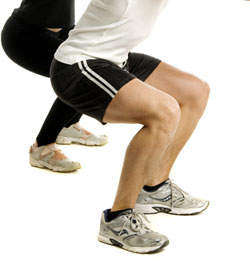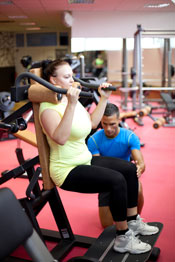
No gym necessary. You can easily do it around the home.
Doing The Right Exercises For Pain Relief
By Sherwin Nicholson | Updated May 1, 2020
How do you know if your current treatment is right?
Using the right form of exercise is vital as a successful treatment if you have issues with lower back pain.
However, how you do it can either improve your symptoms or worsen them. The KEY factor is that your plan must ensure that the muscles that are keeping your spine balanced and aligned are stable.
Many activities and even some exercises and stretches we use, don’t protect us well enough. And some are the reason that we have developed the pain.
A general rule of thumb is that if your method focuses of your core and keeps your spine in neutral posture, then it’s correct. This is a ‘back safe’ practice.
The Core
 The ‘Core’ is often referred to as the area of the body that many fitness athletes and trainers emphasize
The ‘Core’ is often referred to as the area of the body that many fitness athletes and trainers emphasize
A healthy spine that is able to function without any discomfort in an active lifestyle relies on a strong and stable core.
The core refers to the ‘core’ muscles of the body. These are the deep muscles of the spine that support the lower back, hips and rest of the entire body.
Your body has major and minor core muscle groups. Major core muscles include erector spinae, longissimus thoracis, rhomboids, splenius, semispinalis, multifidus, rectus abdominus, obliques, transverse abdominis, and the muscles of the pelvic floor.
Minor core muscle include trapezius, latissimus dorsi, and gluteus muscles.
For more details on the muscles groups involved, please see the sections of the website for your Back and Abdominal muscles and the Hip Flexors and Hamstrings page.
Everyday functional movements that you perform are dependent on the muscles of the core. Whether your core muscles are fit and active or poorly conditioned and weak, they are still the first muscles required. Their level of conditioning affects the degree of stress and pressure placed on the lumbar spine.
A strong and conditioned core keeps the spine and pelvis stable and allows the rest of the body to move more effectively. A weak core leads to back pain and injury. It is more important to develop a strong core than it is to develop the other muscles of the body during times of exercise, training and sports activity. These activities will benefit with core development and recovery time will improve. 
Core muscles have a static and dynamic element to them. A dynamic function is when they are active during times of movement. Static function when there is no movement of the body and the muscles are simply being used in instances of standing or sitting upright. Here your muscles sustain a constant weight and pressure, and endurance is required.
If your core muscles do not have an adequate static function, you are more likely to fatigue when performing many simple tasks such as standing in line, sitting for extended periods of time or even carefully putting on small articles of clothing.
Core muscles are very difficult to train because the majority of them are not visible and do not appear more developed with training.
Simply training only the muscles groups that we find attractive in the mirror may seem to help to keep us fit and feel better about ourselves but offer little lumbar protection.
Core muscle training may not give obvious visual benefits that may boost your self-image or easily show progress in a fitness routine, but they demonstrate their worth when tested ‘during’ the activity itself.
Some exceptions are the abdominals and the gluteal muscles. The conditioning and fitness of the core muscles are more apparent during the actual exercise itself, and their ability is recognized more during extended use.
You will notice more relief when your core also improves. This improvement in your core will happen when your dynamic and static function improves. Functional improvement allows us to have more stability, balance, strength and endurance which directly affects the lower back.
Obstacles
 When trying to recondition your core muscle groups, there is a huge barrier that prevents you from making needed progress.
When trying to recondition your core muscle groups, there is a huge barrier that prevents you from making needed progress.
Most people suffering are already in a state where the core muscles have lost too much strength, stamina, and many other muscles have become tight/guarded to prevent further nerve related injury and pain.
Over time, chronic stiffness, tightness and muscle guarding (a protective action of the muscle) have occurred so much that mobility has become very limited and challenging. It’s hard one to perform the exercise if they physically feel limited. One may even believe that their body is not physically as ‘flexible’ as they think and avoid participation.
Through careful, slow steps, tightness, weakness, flexibility and mobility can improve, and the requirements of the treatment and program will become less challenging and progress.
For most of us this is the most difficult part of following a back pain program as it is not the program itself that is not effective, but the commitment and determination of the user during the recovery process.
The purpose of this site is to bring awareness to the different factors that affect your back such as the involvement of the core muscles. It is also to provide a low back exercise program that will help to develop and condition these areas to provide long-term pain relief and prevention.
If you would like more support:
Why should I exercise? Isn’t it risky?
Do these simple movements and stretches for relief
References:
See the Sitewide References page
